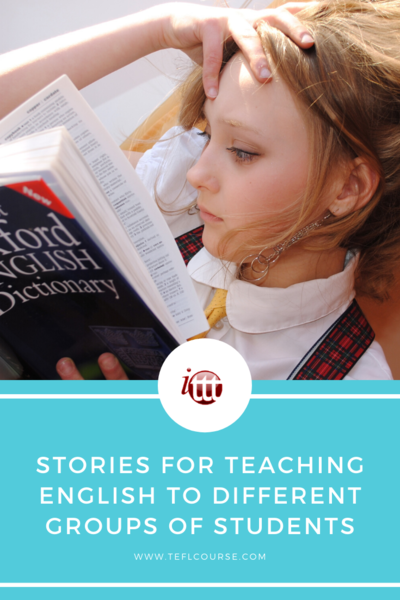Stories for Teaching English to Different Groups of Students

Reading is one of the key elements for all English learners. By reading authentic stories and books, not only do we learn reading and understanding the text we are working with, but we also expand our vocabulary by discovering new authentic words you wouldn't be able to find in your course books, and more importantly, you can see it in context which makes it easier to remember and use those words and structures in the future.
Table of Contents
Do you want to teach English abroad? Take a TEFL course!
This post was written by our TEFL certification graduate Julia P. Please note that this blog post might not necessarily represent the beliefs or opinions of ITTT.
Younger Students
It's important to know which stories to choose based on your student's age and English level. Younger learners would find illustrated books with short stories for children easier to understand since native speaking kids don't have an extensive vocabulary at that age, and just as the students from other countries, are seeking to learn more words that appropriate to their age. In my experience, kids find Little "Red Riding Hood" and other similar fairy tails very engaging and interesting to read in class and at home as homework. It's important to learn that no matter how much the story or book you found is adapted for a certain language level, it is crucial to keep the stories interesting for young kids, for them to have any desire to read it.

Also Read: What does TEFL mean?
Teens and Adults
Teenagers and adults are often interested in classic literature. Alice in Wonderland is known to be one of the most favorite books for those who just start reading in English. It doesn't have a complex vocabulary and keeps both teenagers and adults engaged while reading and studying. Short fiction stories or flash fiction stories can also benefit a lot of students. It's not too long to get tired or bored and lose your motivation to finish it, and most of the time it has an interesting plot. Using flash fiction can help to cover more than one theme within the class and therefore explore more diverse vocabulary.
Also Read: Where to take a TEFL course?
Resources
Another way to teach English through stories is to use real stories from magazines or online newspapers such as the New York Times or New Yorker. They are filled with interesting meaningful short stories and can often engage teenagers and adults. When using authentic stories from the newspapers it is important to look over the stories you're going to use to make sure that all vocabulary would be appropriate for your students and their current English level. It is helpful to write down the words your students most likely don't know but would find very useful in the future, and pre-teach the new vocabulary before giving out the reading material.
Do you want to teach English abroad? Take a TEFL course!
It's important to always remember to stick to the English level and age of the group when choosing the stories for your class. There're a lot of publishers who can offer any kind of literature adapted to a certain language level to make the educational process easier. You don't want the beginners to read stories written and adapted for upper-intermediate learners, just like you don't want to give your adult beginner students to read a fairy tale, even if it's appropriate to his language level.
Apply now & get certified to teach english abroad!
Speak with an ITTT advisor today to put together your personal plan for teaching English abroad.
Send us an email or call us toll-free at 1-800-490-0531 to speak with an ITTT advisor today.
Related Articles:
- Evaluation and Testing of Students in the ESL Classroom
- My Personal Teaching Experience - The Different Roles of an ESL Teacher
- The Benefits of Having Good Rapport with Students
- The Best Thing I've Learned From My TEFL/TESOL Course
- All the Documents You Will Need to Teach English Abroad
- Getting Student Placement Right - The Best Desk Arrangements for EFL Students




